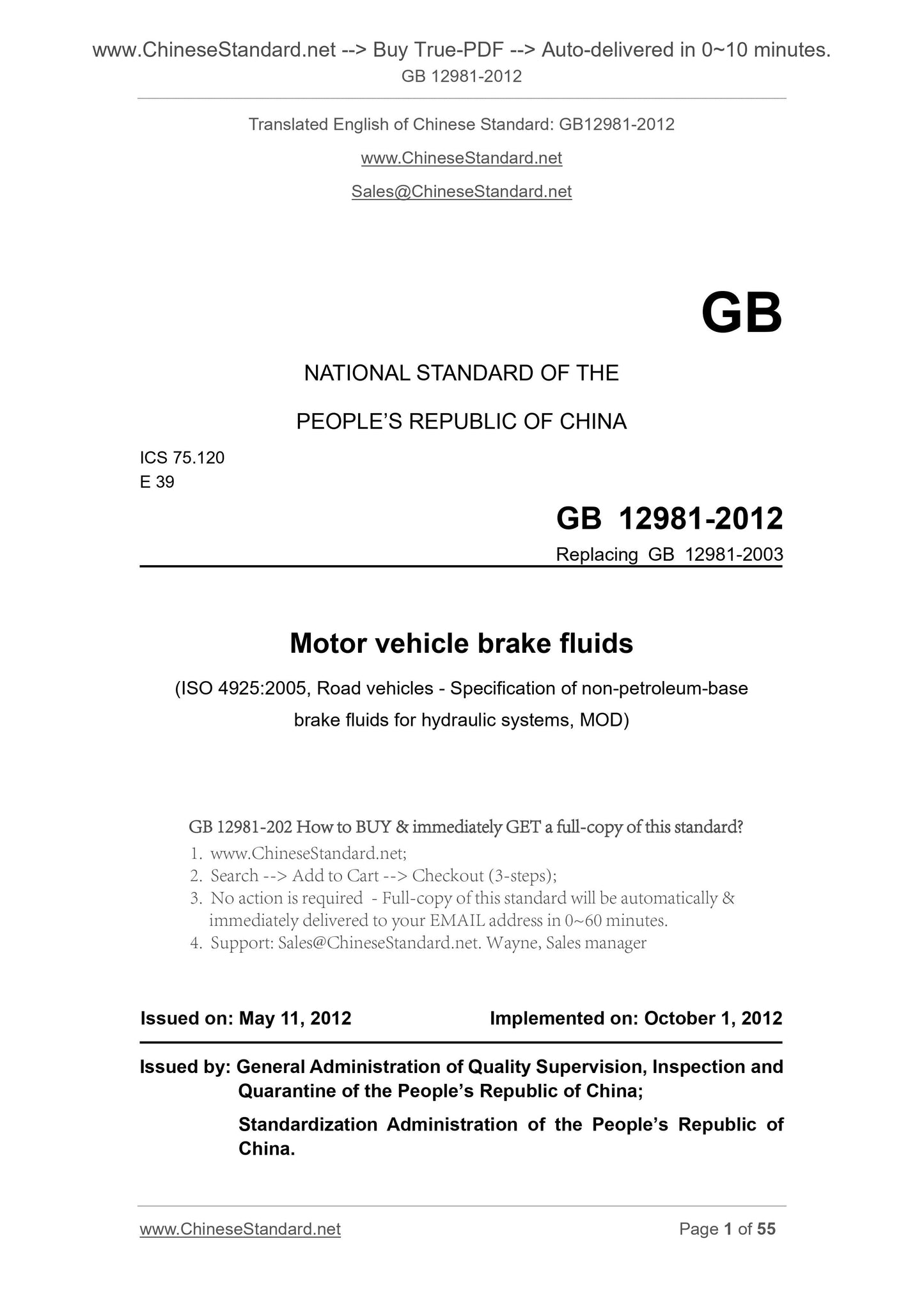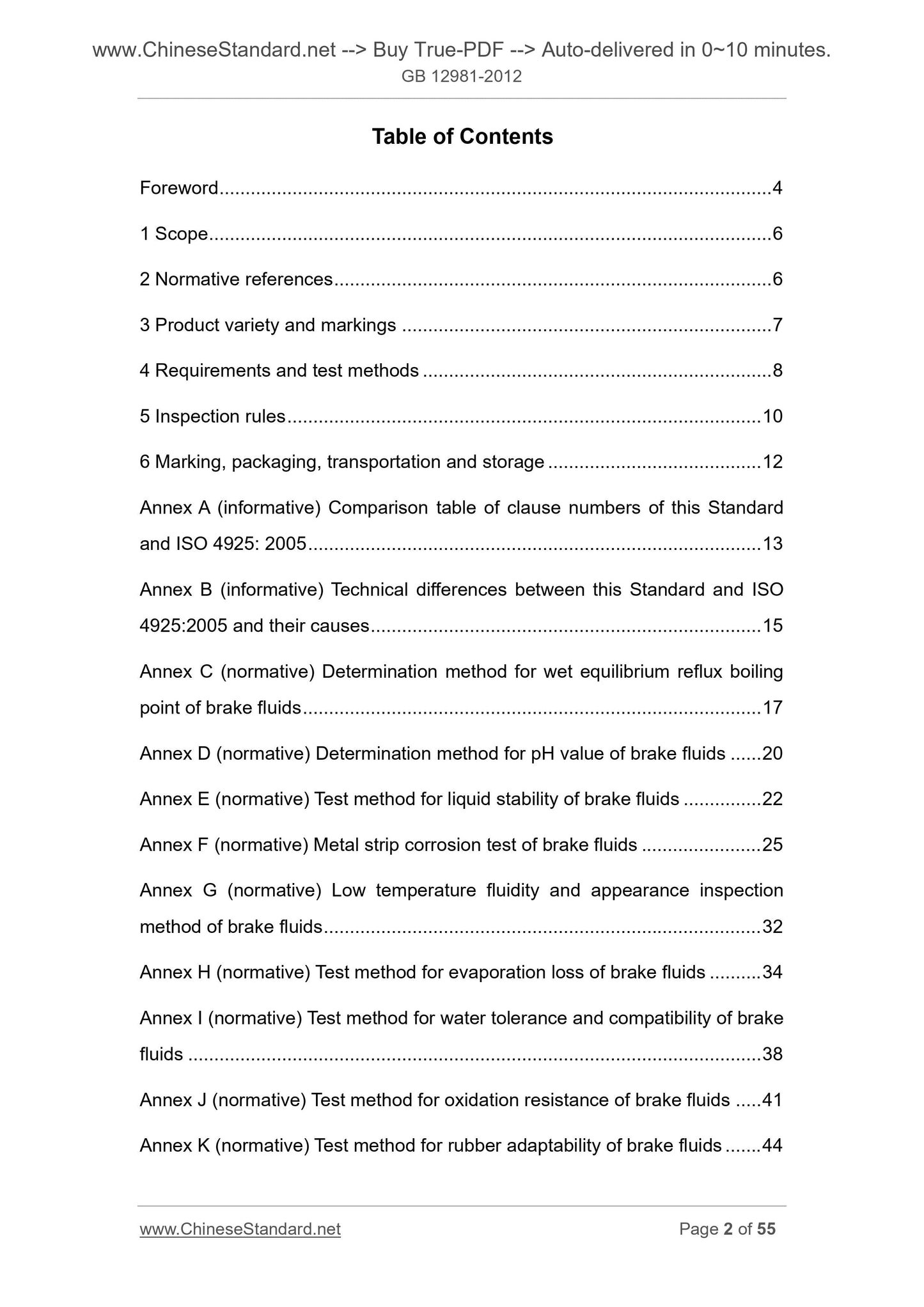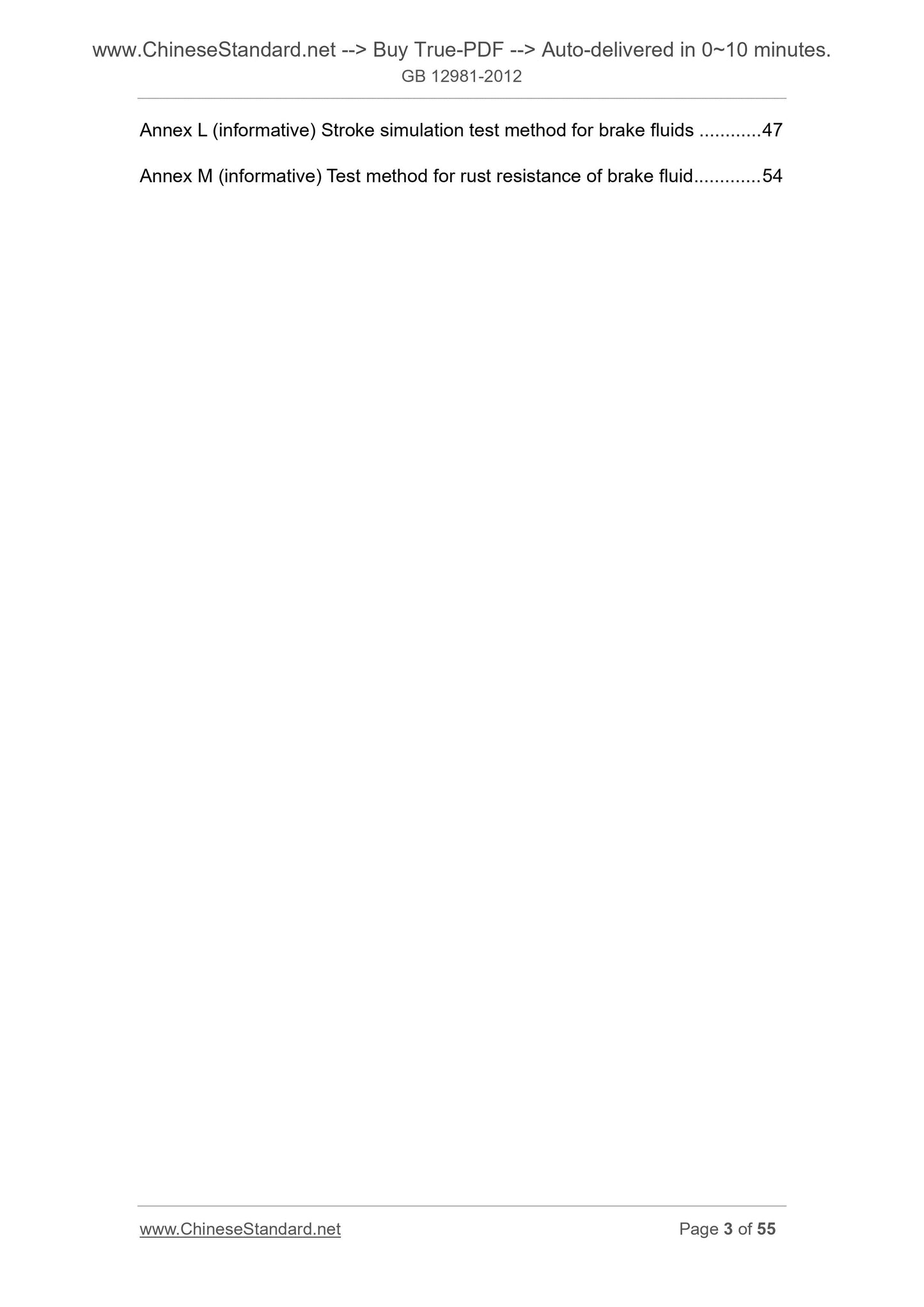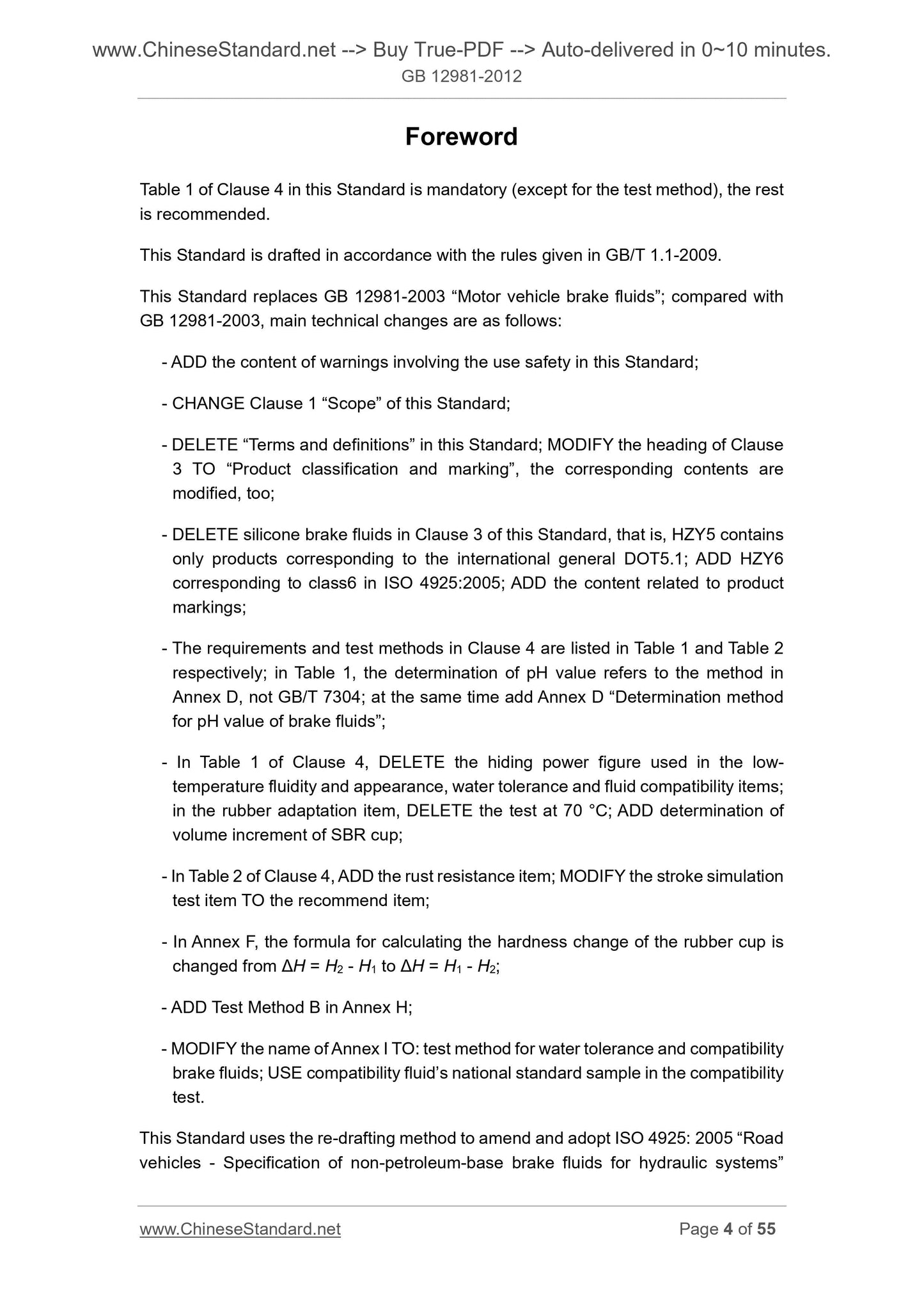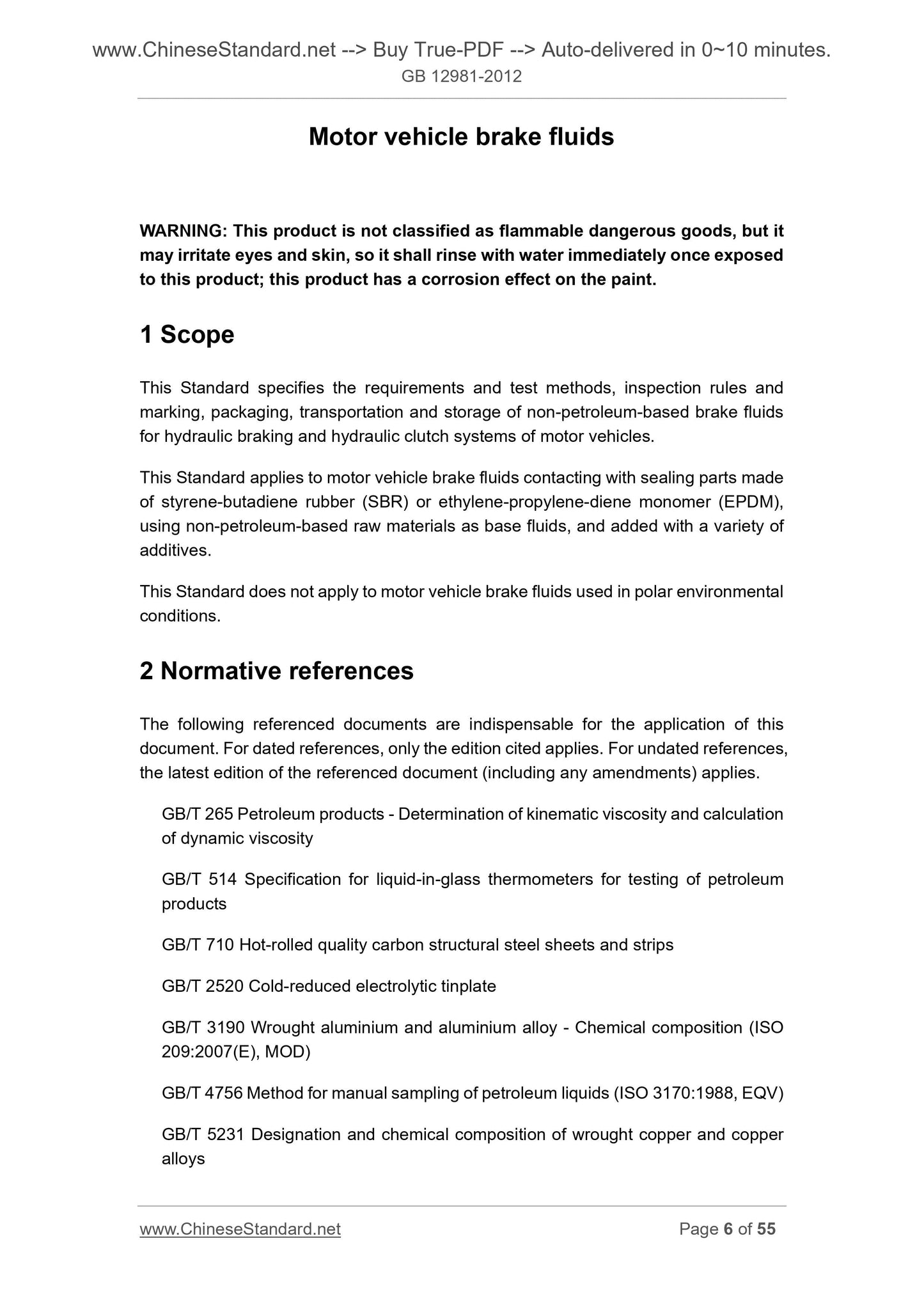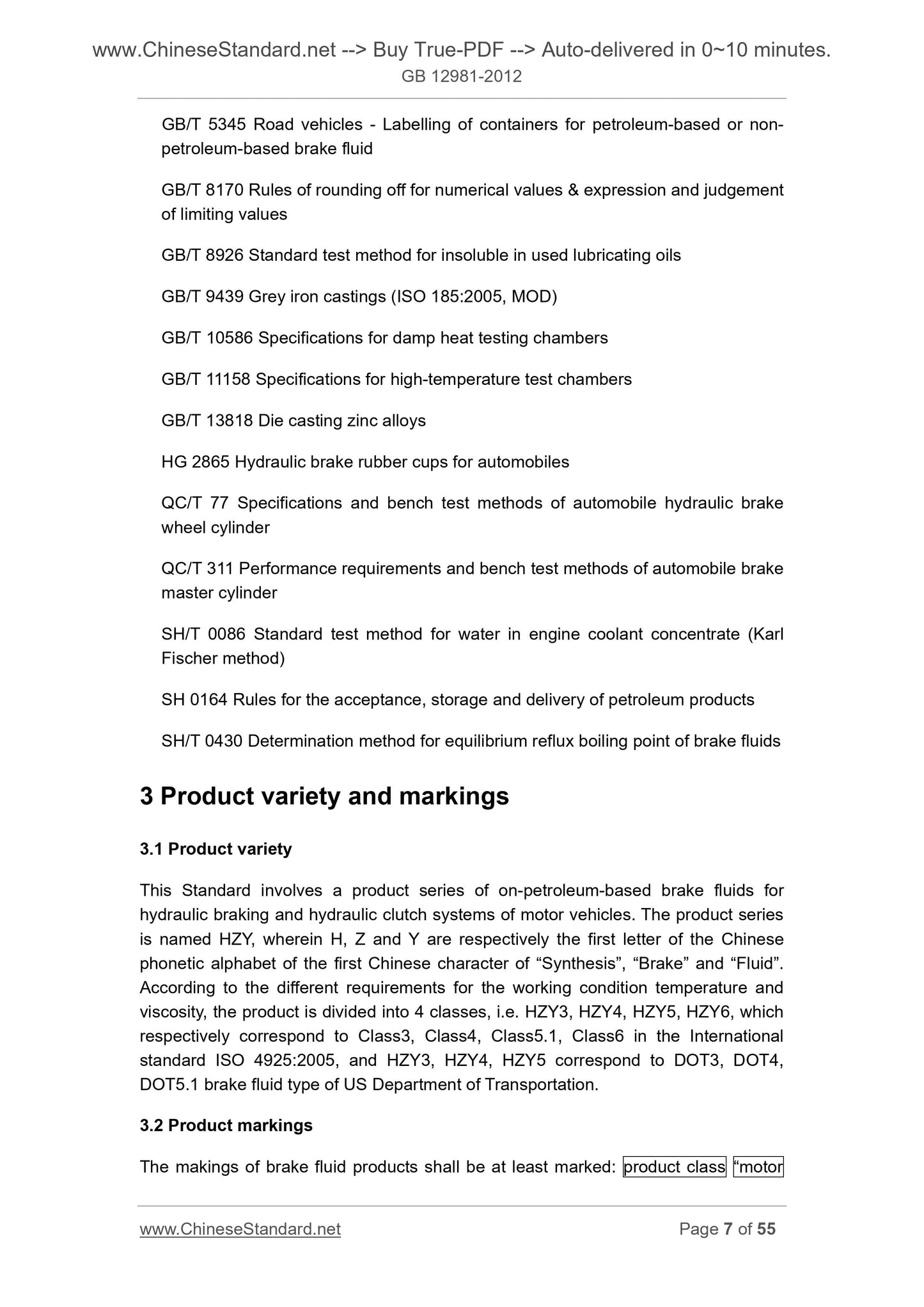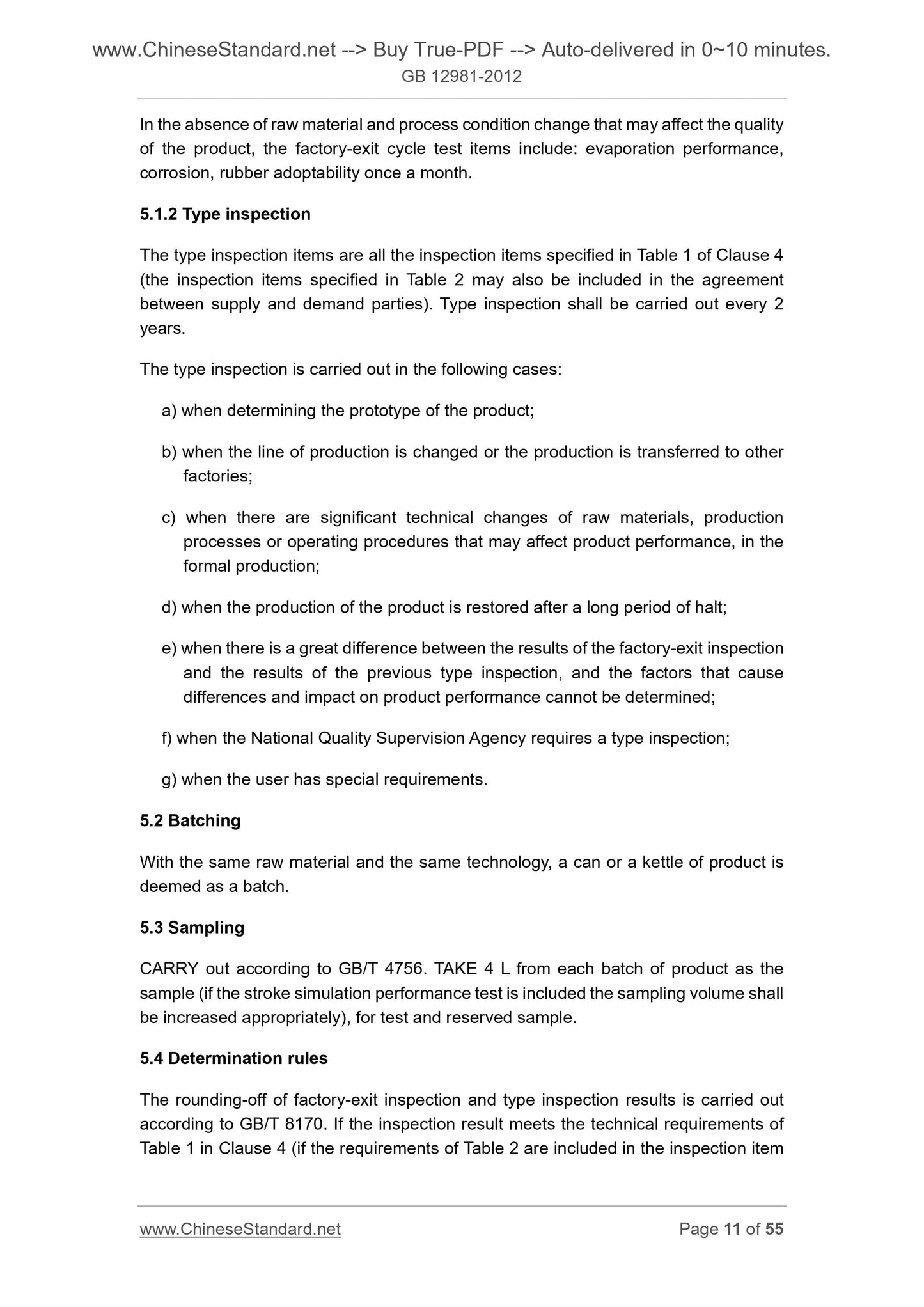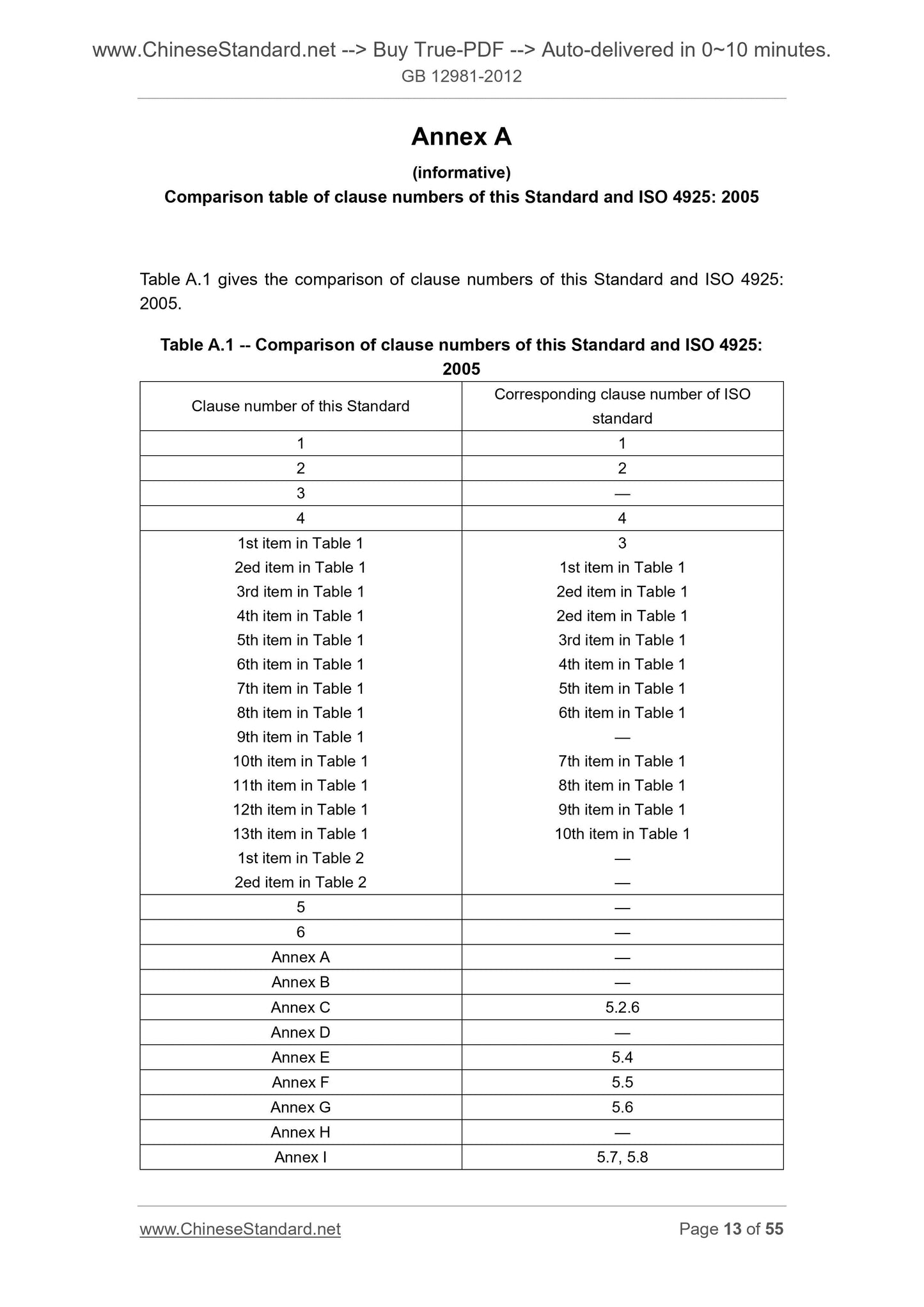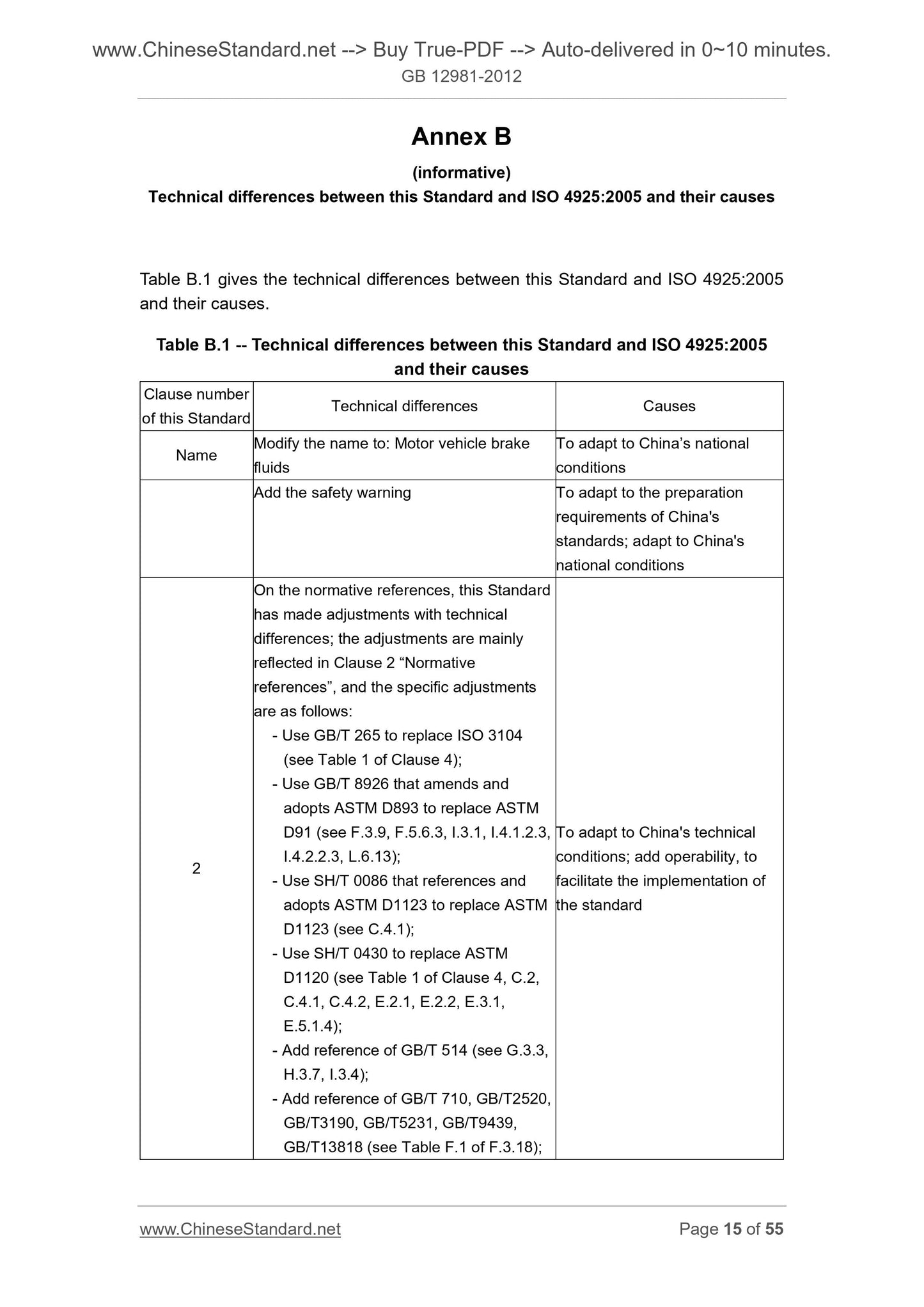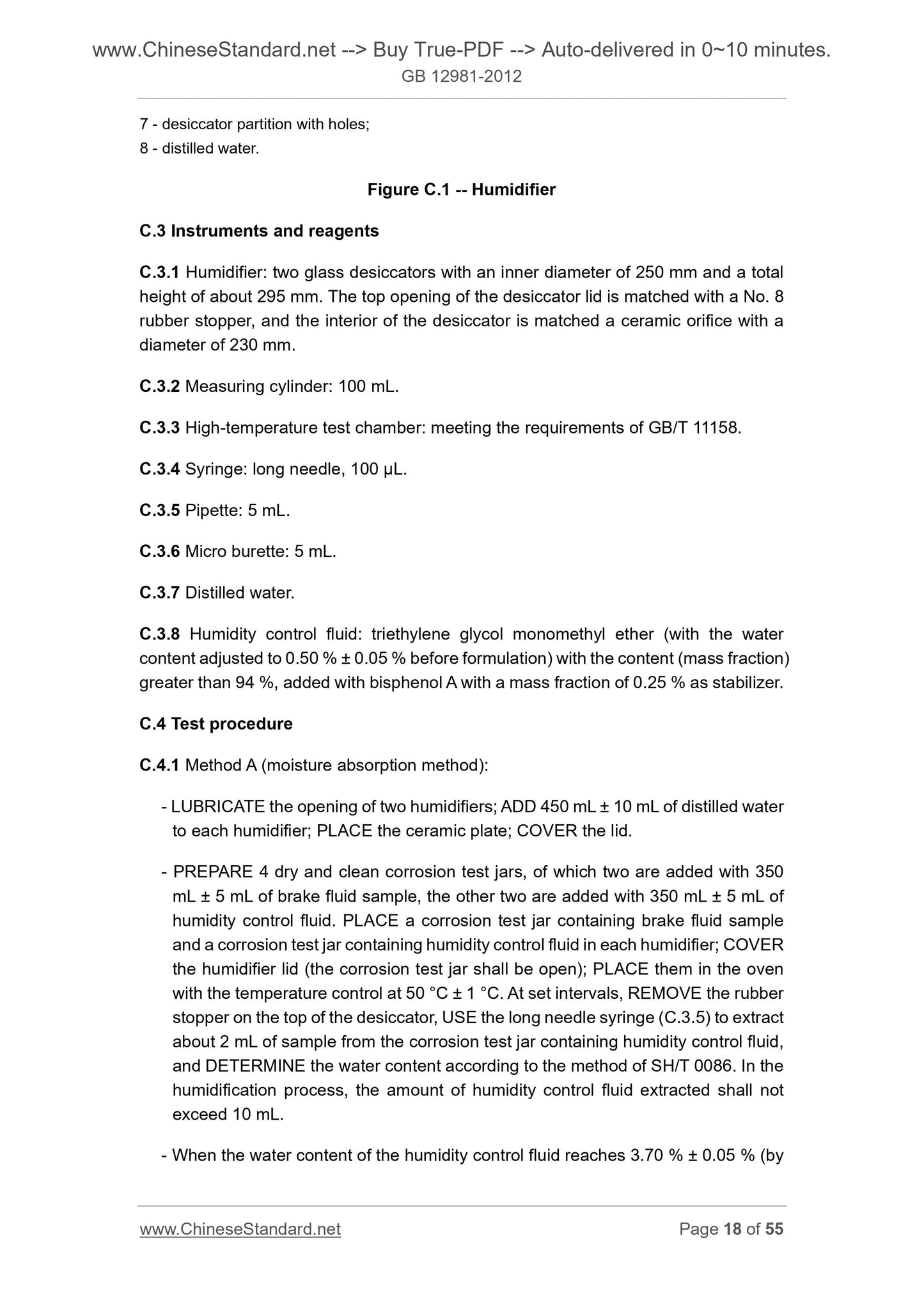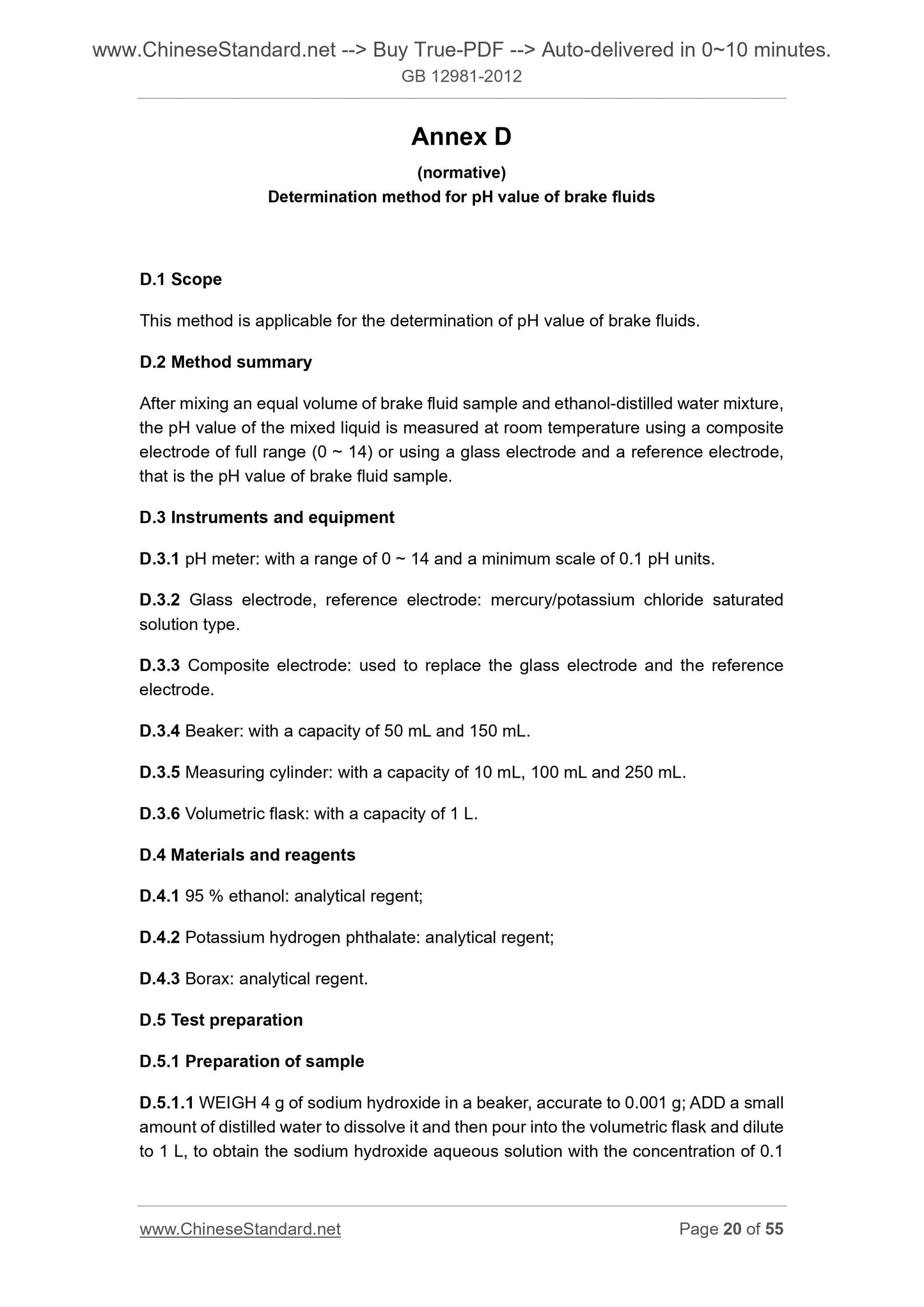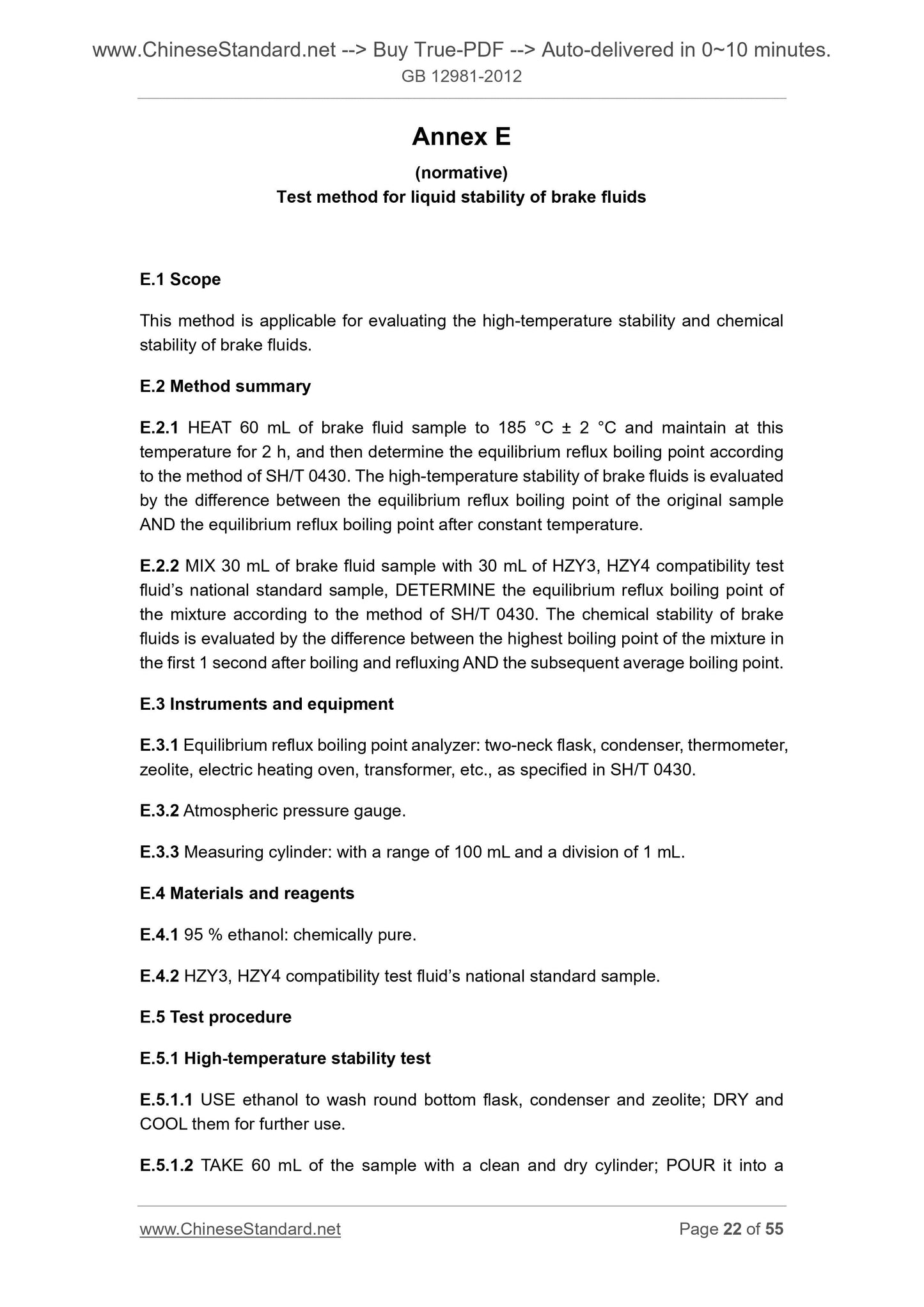1
/
of
12
PayPal, credit cards. Download editable-PDF & invoice in 1 second!
GB 12981-2012 English PDF
GB 12981-2012 English PDF
Regular price
$145.00 USD
Regular price
Sale price
$145.00 USD
Unit price
/
per
Shipping calculated at checkout.
Couldn't load pickup availability
Delivery: 3 seconds. Download true-PDF + Invoice.
Get QUOTATION in 1-minute: Click GB 12981-2012
Historical versions: GB 12981-2012
Preview True-PDF (Reload/Scroll if blank)
GB 12981-2012: Motor vehicle brake fluids
GB 12981-2012
GB
NATIONAL STANDARD OF THE
PEOPLE’S REPUBLIC OF CHINA
ICS 75.120
E 39
Replacing GB 12981-2003
Motor vehicle brake fluids
(ISO 4925.2005, Road vehicles - Specification of non-petroleum-base brake
fluids for hydraulic systems, MOD)
ISSUED ON. MAY 11, 2012
IMPLEMENTED ON. OCTOBER 1, 2012
Issued by. General Administration of Quality Supervision, Inspection and
Quarantine of the People’s Republic of China;
Standardization Administration of the People’s Republic of
China.
3. No action is required - Full-copy of this standard will be automatically and
immediately delivered to your EMAIL address in 0~60 minutes.
Table of Contents
Foreword ... 4
1 Scope ... 6
2 Normative references ... 6
3 Product variety and markings ... 7
4 Requirements and test methods ... 8
5 Inspection rules ... 10
6 Marking, packaging, transportation and storage ... 12
Annex A (informative) Comparison table of clause numbers of this Standard
and ISO 4925. 2005 ... 13
Annex B (informative) Technical differences between this Standard and ISO
4925.2005 and their causes ... 15
Annex C (normative) Determination method for wet equilibrium reflux boiling
point of brake fluids ... 17
Annex D (normative) Determination method for pH value of brake fluids ... 20
Annex E (normative) Test method for liquid stability of brake fluids ... 22
Annex F (normative) Metal strip corrosion test of brake fluids ... 25
Annex G (normative) Low temperature fluidity and appearance inspection
method of brake fluids ... 32
Annex H (normative) Test method for evaporation loss of brake fluids ... 34
Annex I (normative) Test method for water tolerance and compatibility of brake
fluids ... 38
Annex J (normative) Test method for oxidation resistance of brake fluids ... 41
Annex K (normative) Test method for rubber adaptability of brake fluids ... 44
Annex L (informative) Stroke simulation test method for brake fluids ... 47
Annex M (informative) Test method for rust resistance of brake fluid ... 54
Foreword
Table 1 of Clause 4 in this Standard is mandatory (except for the test method), the rest
is recommended.
This Standard is drafted in accordance with the rules given in GB/T 1.1-2009.
This Standard replaces GB 12981-2003 “Motor vehicle brake fluids”; compared with
GB 12981-2003, main technical changes are as follows.
- ADD the content of warnings involving the use safety in this Standard;
- CHANGE Clause 1 “Scope” of this Standard;
- DELETE “Terms and definitions” in this Standard; MODIFY the heading of Clause
3 TO “Product classification and marking”, the corresponding contents are
modified, too;
- DELETE silicone brake fluids in Clause 3 of this Standard, that is, HZY5 contains
only products corresponding to the international general DOT5.1; ADD HZY6
corresponding to class6 in ISO 4925.2005; ADD the content related to product
markings;
- The requirements and test methods in Clause 4 are listed in Table 1 and Table 2
respectively; in Table 1, the determination of pH value refers to the method in
Annex D, not GB/T 7304; at the same time add Annex D “Determination method
for pH value of brake fluids”;
- In Table 1 of Clause 4, DELETE the hiding power figure used in the low-
temperature fluidity and appearance, water tolerance and fluid compatibility items;
in the rubber adaptation item, DELETE the test at 70 °C; ADD determination of
volume increment of SBR cup;
- In Table 2 of Clause 4, ADD the rust resistance item; MODIFY the stroke simulation
test item TO the recommend item;
- In Annex F, the formula for calculating the hardness change of the rubber cup is
changed from ΔH = H2 - H1 to ΔH = H1 - H2;
- ADD Test Method B in Annex H;
- MODIFY the name of Annex I TO. test method for water tolerance and compatibility
brake fluids; USE compatibility fluid’s national standard sample in the compatibility
test.
This Standard uses the re-drafting method to amend and adopt ISO 4925. 2005 “Road
vehicles - Specification of non-petroleum-base brake fluids for hydraulic systems”
Motor vehicle brake fluids
WARNING. This product is not classified as flammable dangerous goods, but it
may irritate eyes and skin, so it shall rinse with water immediately once exposed
to this product; this product has a corrosion effect on the paint.
1 Scope
This Standard specifies the requirements and test methods, inspection rules and
marking, packaging, transportation and storage of non-petroleum-based brake fluids
for hydraulic braking and hydraulic clutch systems of motor vehicles.
This Standard applies to motor vehicle brake fluids contacting with sealing parts made
of styrene-butadiene rubber (SBR) or ethylene-propylene-diene monomer (EPDM),
using non-petroleum-based raw materials as base fluids, and added with a variety of
additives.
This Standard does not apply to motor vehicle brake fluids used in polar environmental
conditions.
2 Normative references
The following referenced documents are indispensable for the application of this
document. For dated references, only the edition cited applies. For undated references,
the latest edition of the referenced document (including any amendments) applies.
GB/T 265 Petroleum products - Determination of kinematic viscosity and calculation
of dynamic viscosity
GB/T 514 Specification for liquid-in-glass thermometers for testing of petroleum
products
GB/T 710 Hot-rolled quality carbon structural steel sheets and strips
GB/T 2520 Cold-reduced electrolytic tinplate
GB/T 3190 Wrought aluminium and aluminium alloy - Chemical composition (ISO
209.2007(E), MOD)
GB/T 4756 Method for manual sampling of petroleum liquids (ISO 3170.1988, EQV)
GB/T 5231 Designation and chemical composition of wrought copper and copper
alloys
GB/T 5345 Road vehicles - Labelling of containers for petroleum-based or non-
petroleum-based brake fluid
GB/T 8170 Rules of rounding off for numerical values and expression and judgement
of limiting values
GB/T 8926 Standard test method for insoluble in used lubricating oils
GB/T 9439 Grey iron castings (ISO 185.2005, MOD)
GB/T 10586 Specifications for damp heat testing chambers
GB/T 11158 Specifications for high-temperature test chambers
GB/T 13818 Die casting zinc alloys
HG 2865 Hydraulic brake rubber cups for automobiles
QC/T 77 Specifications and bench test methods of automobile hydraulic brake
wheel cylinder
QC/T 311 Performance requirements and bench test methods of automobile brake
master cylinder
SH/T 0086 Standard test method for water in engine coolant concentrate (Karl
Fischer method)
SH 0164 Rules for the acceptance, storage and delivery of petroleum products
SH/T 0430 Determination method for equilibrium reflux boiling point of brake fluids
3 Product variety and markings
3.1 Product variety
This Standard involves a product series of on-petroleum-based brake fluids for
hydraulic braking and hydraulic clutch systems of motor vehicles. The product series
is named HZY, wherein H, Z and Y are respectively the first letter of the Chinese
phonetic alphabet of the first Chinese character of “Synthesis”, “Brake” and “Fluid”.
According to the different requirements for the working condition temperature and
viscosity, the product is divided into 4 classes, i.e. HZY3, HZY4, HZY5, HZY6, which
respectively correspond to Class3, Class4, Class5.1, Class6 in the International
standard ISO 4925.2005, and HZY3, HZY4, HZY5 correspond to DOT3...
Get QUOTATION in 1-minute: Click GB 12981-2012
Historical versions: GB 12981-2012
Preview True-PDF (Reload/Scroll if blank)
GB 12981-2012: Motor vehicle brake fluids
GB 12981-2012
GB
NATIONAL STANDARD OF THE
PEOPLE’S REPUBLIC OF CHINA
ICS 75.120
E 39
Replacing GB 12981-2003
Motor vehicle brake fluids
(ISO 4925.2005, Road vehicles - Specification of non-petroleum-base brake
fluids for hydraulic systems, MOD)
ISSUED ON. MAY 11, 2012
IMPLEMENTED ON. OCTOBER 1, 2012
Issued by. General Administration of Quality Supervision, Inspection and
Quarantine of the People’s Republic of China;
Standardization Administration of the People’s Republic of
China.
3. No action is required - Full-copy of this standard will be automatically and
immediately delivered to your EMAIL address in 0~60 minutes.
Table of Contents
Foreword ... 4
1 Scope ... 6
2 Normative references ... 6
3 Product variety and markings ... 7
4 Requirements and test methods ... 8
5 Inspection rules ... 10
6 Marking, packaging, transportation and storage ... 12
Annex A (informative) Comparison table of clause numbers of this Standard
and ISO 4925. 2005 ... 13
Annex B (informative) Technical differences between this Standard and ISO
4925.2005 and their causes ... 15
Annex C (normative) Determination method for wet equilibrium reflux boiling
point of brake fluids ... 17
Annex D (normative) Determination method for pH value of brake fluids ... 20
Annex E (normative) Test method for liquid stability of brake fluids ... 22
Annex F (normative) Metal strip corrosion test of brake fluids ... 25
Annex G (normative) Low temperature fluidity and appearance inspection
method of brake fluids ... 32
Annex H (normative) Test method for evaporation loss of brake fluids ... 34
Annex I (normative) Test method for water tolerance and compatibility of brake
fluids ... 38
Annex J (normative) Test method for oxidation resistance of brake fluids ... 41
Annex K (normative) Test method for rubber adaptability of brake fluids ... 44
Annex L (informative) Stroke simulation test method for brake fluids ... 47
Annex M (informative) Test method for rust resistance of brake fluid ... 54
Foreword
Table 1 of Clause 4 in this Standard is mandatory (except for the test method), the rest
is recommended.
This Standard is drafted in accordance with the rules given in GB/T 1.1-2009.
This Standard replaces GB 12981-2003 “Motor vehicle brake fluids”; compared with
GB 12981-2003, main technical changes are as follows.
- ADD the content of warnings involving the use safety in this Standard;
- CHANGE Clause 1 “Scope” of this Standard;
- DELETE “Terms and definitions” in this Standard; MODIFY the heading of Clause
3 TO “Product classification and marking”, the corresponding contents are
modified, too;
- DELETE silicone brake fluids in Clause 3 of this Standard, that is, HZY5 contains
only products corresponding to the international general DOT5.1; ADD HZY6
corresponding to class6 in ISO 4925.2005; ADD the content related to product
markings;
- The requirements and test methods in Clause 4 are listed in Table 1 and Table 2
respectively; in Table 1, the determination of pH value refers to the method in
Annex D, not GB/T 7304; at the same time add Annex D “Determination method
for pH value of brake fluids”;
- In Table 1 of Clause 4, DELETE the hiding power figure used in the low-
temperature fluidity and appearance, water tolerance and fluid compatibility items;
in the rubber adaptation item, DELETE the test at 70 °C; ADD determination of
volume increment of SBR cup;
- In Table 2 of Clause 4, ADD the rust resistance item; MODIFY the stroke simulation
test item TO the recommend item;
- In Annex F, the formula for calculating the hardness change of the rubber cup is
changed from ΔH = H2 - H1 to ΔH = H1 - H2;
- ADD Test Method B in Annex H;
- MODIFY the name of Annex I TO. test method for water tolerance and compatibility
brake fluids; USE compatibility fluid’s national standard sample in the compatibility
test.
This Standard uses the re-drafting method to amend and adopt ISO 4925. 2005 “Road
vehicles - Specification of non-petroleum-base brake fluids for hydraulic systems”
Motor vehicle brake fluids
WARNING. This product is not classified as flammable dangerous goods, but it
may irritate eyes and skin, so it shall rinse with water immediately once exposed
to this product; this product has a corrosion effect on the paint.
1 Scope
This Standard specifies the requirements and test methods, inspection rules and
marking, packaging, transportation and storage of non-petroleum-based brake fluids
for hydraulic braking and hydraulic clutch systems of motor vehicles.
This Standard applies to motor vehicle brake fluids contacting with sealing parts made
of styrene-butadiene rubber (SBR) or ethylene-propylene-diene monomer (EPDM),
using non-petroleum-based raw materials as base fluids, and added with a variety of
additives.
This Standard does not apply to motor vehicle brake fluids used in polar environmental
conditions.
2 Normative references
The following referenced documents are indispensable for the application of this
document. For dated references, only the edition cited applies. For undated references,
the latest edition of the referenced document (including any amendments) applies.
GB/T 265 Petroleum products - Determination of kinematic viscosity and calculation
of dynamic viscosity
GB/T 514 Specification for liquid-in-glass thermometers for testing of petroleum
products
GB/T 710 Hot-rolled quality carbon structural steel sheets and strips
GB/T 2520 Cold-reduced electrolytic tinplate
GB/T 3190 Wrought aluminium and aluminium alloy - Chemical composition (ISO
209.2007(E), MOD)
GB/T 4756 Method for manual sampling of petroleum liquids (ISO 3170.1988, EQV)
GB/T 5231 Designation and chemical composition of wrought copper and copper
alloys
GB/T 5345 Road vehicles - Labelling of containers for petroleum-based or non-
petroleum-based brake fluid
GB/T 8170 Rules of rounding off for numerical values and expression and judgement
of limiting values
GB/T 8926 Standard test method for insoluble in used lubricating oils
GB/T 9439 Grey iron castings (ISO 185.2005, MOD)
GB/T 10586 Specifications for damp heat testing chambers
GB/T 11158 Specifications for high-temperature test chambers
GB/T 13818 Die casting zinc alloys
HG 2865 Hydraulic brake rubber cups for automobiles
QC/T 77 Specifications and bench test methods of automobile hydraulic brake
wheel cylinder
QC/T 311 Performance requirements and bench test methods of automobile brake
master cylinder
SH/T 0086 Standard test method for water in engine coolant concentrate (Karl
Fischer method)
SH 0164 Rules for the acceptance, storage and delivery of petroleum products
SH/T 0430 Determination method for equilibrium reflux boiling point of brake fluids
3 Product variety and markings
3.1 Product variety
This Standard involves a product series of on-petroleum-based brake fluids for
hydraulic braking and hydraulic clutch systems of motor vehicles. The product series
is named HZY, wherein H, Z and Y are respectively the first letter of the Chinese
phonetic alphabet of the first Chinese character of “Synthesis”, “Brake” and “Fluid”.
According to the different requirements for the working condition temperature and
viscosity, the product is divided into 4 classes, i.e. HZY3, HZY4, HZY5, HZY6, which
respectively correspond to Class3, Class4, Class5.1, Class6 in the International
standard ISO 4925.2005, and HZY3, HZY4, HZY5 correspond to DOT3...
Share
